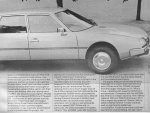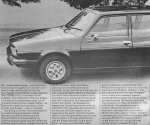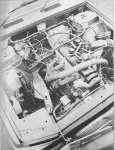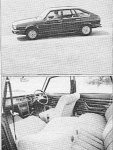
You are using an out of date browser. It may not display this or other websites correctly.
You should upgrade or use an alternative browser.
You should upgrade or use an alternative browser.
Magazine Article: R20TS vs CX Athena
- Thread starter DoubleChevron
- Start date
Source: Car. Oct '79
snatching in the Citroen's poorly cushioned drivetrain. The Renault is much more forgiving and the easier of the two cars to drive smoothly. ln the low and mid-speed ranges, lower gearing makes the Renault's pickup in fourth and fifth brisker than the Citroens but this advantage is offset at higher speeds by the Athenas superior aerodynamics which give it a clear 5mph advantage on top speed.
More to the point, higher gearing and better streamlining make the Citroen significantly less thirsty. All three DOE tests - at 56mp it is doing 40mpg - show the Athena to have a clear-cut advantage which our own measurements confirm.
Longer legs mean less mechanical fiats and noise too, though the Athena's superior engine refinement does not stem entirely from higher ratios. Citroen have all but eliminated the boom period around 4000rpm that was quite obtrusive in the Peugeot 505 we drove in France, and plainly evident in the Renault tested here.
You can certainly hear and feel the Athena's engine throb when it's extended in the lower gears towards the 57O0rpm red sector. but at its natural 90mph cruising gait - about 40OOrpm on the vague revolving drum rev counter - the Citroen is a very quiet car and demonstrably more relaxed and peaceful than the Renault in which engine, wind and road roar (plus gear whine in fifth) merge as one prominent whoosh at speed. In short, Citroen have utilised the co-operative engine rather better than Peugeot and Renault - not that they've done a bad job.
Improvements to the Citroen are not confined to its performance. The lighter (by 110lbs) engine/cooling system has allowed the use of even softer front suspension, and the awkward and obstructive gearchange of early CX five-speeders has given way to a lever that slips cleanly and easily through a rather floppy gate with minimal baulking.
The clutch has a smoother, more progressive action than before too. With the acquisition of a respectable gearchange a flaw that marred the manual CX as a driver's car par excellence has been eliminated. The super-responsive powered steering may be initially un- nerving to anyone unused to such sharp reactions from small inputs: powered self-centering and very high gearing demands an extremely sensitive touch, particularly when unwinding, to avoid zig-zag cornering and over correction. The long wheelbase also calls for a wide-angle
approach to sharp turns and driveways.
But live with Varipower steering for a bit and that of all other cars will feel by comparison cumbersome and lethargy.
The unyielding wooden feel of the pressure-sensitive all-disc powered brakes also needs acclimatisation to prevent head-snapping jerks both on application and release, particularly at low speeds.
But what fantastic brakes! They arrest this big car without dive or deviation from high speed with an almost uncanny sense of poise and power.
Poise: yes, that's the secret to the Citroens ride too. It is not so much that the hydropneumatic suspension eliminates jars and jolts. It doesn't: you can feel and hear the big Michelins thumping over bumps and troughs, though the noise is well muffled and the disturbance small.
It is more the car's stability over awkward cambers and dips rather than its handling I of surface irregularities that gives the Citroen such remarkable balance and composure. Its roadholding is outstanding and the grip seemingly as tenacious under braking on bumpy corners as it is when the goings good. It is a brave driver who pushes on towards the very high limit of adhesion and a foolhardy one who
snatching in the Citroen's poorly cushioned drivetrain. The Renault is much more forgiving and the easier of the two cars to drive smoothly. ln the low and mid-speed ranges, lower gearing makes the Renault's pickup in fourth and fifth brisker than the Citroens but this advantage is offset at higher speeds by the Athenas superior aerodynamics which give it a clear 5mph advantage on top speed.
More to the point, higher gearing and better streamlining make the Citroen significantly less thirsty. All three DOE tests - at 56mp it is doing 40mpg - show the Athena to have a clear-cut advantage which our own measurements confirm.
Longer legs mean less mechanical fiats and noise too, though the Athena's superior engine refinement does not stem entirely from higher ratios. Citroen have all but eliminated the boom period around 4000rpm that was quite obtrusive in the Peugeot 505 we drove in France, and plainly evident in the Renault tested here.
You can certainly hear and feel the Athena's engine throb when it's extended in the lower gears towards the 57O0rpm red sector. but at its natural 90mph cruising gait - about 40OOrpm on the vague revolving drum rev counter - the Citroen is a very quiet car and demonstrably more relaxed and peaceful than the Renault in which engine, wind and road roar (plus gear whine in fifth) merge as one prominent whoosh at speed. In short, Citroen have utilised the co-operative engine rather better than Peugeot and Renault - not that they've done a bad job.
Improvements to the Citroen are not confined to its performance. The lighter (by 110lbs) engine/cooling system has allowed the use of even softer front suspension, and the awkward and obstructive gearchange of early CX five-speeders has given way to a lever that slips cleanly and easily through a rather floppy gate with minimal baulking.
The clutch has a smoother, more progressive action than before too. With the acquisition of a respectable gearchange a flaw that marred the manual CX as a driver's car par excellence has been eliminated. The super-responsive powered steering may be initially un- nerving to anyone unused to such sharp reactions from small inputs: powered self-centering and very high gearing demands an extremely sensitive touch, particularly when unwinding, to avoid zig-zag cornering and over correction. The long wheelbase also calls for a wide-angle
approach to sharp turns and driveways.
But live with Varipower steering for a bit and that of all other cars will feel by comparison cumbersome and lethargy.
The unyielding wooden feel of the pressure-sensitive all-disc powered brakes also needs acclimatisation to prevent head-snapping jerks both on application and release, particularly at low speeds.
But what fantastic brakes! They arrest this big car without dive or deviation from high speed with an almost uncanny sense of poise and power.
Poise: yes, that's the secret to the Citroens ride too. It is not so much that the hydropneumatic suspension eliminates jars and jolts. It doesn't: you can feel and hear the big Michelins thumping over bumps and troughs, though the noise is well muffled and the disturbance small.
It is more the car's stability over awkward cambers and dips rather than its handling I of surface irregularities that gives the Citroen such remarkable balance and composure. Its roadholding is outstanding and the grip seemingly as tenacious under braking on bumpy corners as it is when the goings good. It is a brave driver who pushes on towards the very high limit of adhesion and a foolhardy one who
Attachments
Source: Car. Oct '79
explores beyond it: recovering a 'lost' big Citroen is for aces only.
although outclassed, the Renault is far from disgraced. By normal standards, its power steering is one of the best, well weighted and fabulously responsible yet feels a bit vague compared with the Citroens. But then everything else does.
held on lock, especially through a long round-a-bout or motorway cloverleaf, the valving squelches and hisses irritatingly, adding to the noise of squealing tyres if you're in a hurry. The big Renault will hustle through corners safely and quickly it doesn't have the roadholding reserves of the Citroen and the body tends heave and roll a bit under spirited cornering especially on poor roads when the ride can lose some of its generally superb composure. The smooth disc/drum brakes, easier to feather on and off than the CX's, are strong and reassuring.
The Renault is a very comfortable car.
You sit tall and plush, embracing armchairs, looking down from a good vantage point over the bonnet. Not that visibility is impaired by the much lower, more reclined driving position in the Citroen : its low sills and concave facia, which creates a feeling of great spaciousness though it is in fact a bit wasteful of space, ensures a commanding view over the long, raked nose. Not everyone will feel completely at home in the Citroen however.
Even though the seat is (awkwardly) adjustable for height as well as reach and rake, the bee-spoke steering wheel tends to rub against your thighs, and tall drivers could do with more rearward movement. There is no convenient resting place for your left foot in the rather narrow foothills either.
The Renault's driving position, pedal layout and four-spoke steering wheel - if not its hand controls - are on the whole preferable. The gearchange is a little more notchy and clonks than the Citroen's though, and the minor switches nothing special. Reaching for the ignition key often means inadvertently operating the adjacent wiper stalk. The Citroens unique switchgear - rockers and toggles strategically arranged at each end of the 'rainbow' instrument cowl within finger stretching reach - is quite outstanding, arguably the best devised until the Visa came along despite the non-self-cancelling indicators.
The same cannot be said of the controversial drum type instruments which are permanently illuminated (a rheostat regulates intensity) beneath a battery of warning lights. The conventional instrument panel of the 20TS will arouse no strong feelings, and there's no question about the superiority of the Renault's excellent ventilation system. Strong throughput can be boosted to a hair- blowing gale, whereas the Citroen will deliver no more than a poorly directed and noisy breeze. The CX's ventilation is better than it was - but it's still not good enough.
Both cars are well appointed and equipped : electric front windows and tinted glass are standard and the Renault also has central locking - but no head restraints. Both cars have cloth-and-plastic trim, although the interior decor- restrained in the Renault, characteristically futuristic in the Citroen - is very different. With its five doors and multi-position seating, the Renault is clearly the more versatile carrier.
For many buyers the innate advantages of this packaging concept will outweigh the streamlined Athena's more striking appearance, superior driving qualities and better economy. But the space-age Citroen, at first more demanding to drive, is the more rewarding once you have come to terms with its unique character and controls. And for the money, it is very good value indeed.
explores beyond it: recovering a 'lost' big Citroen is for aces only.
although outclassed, the Renault is far from disgraced. By normal standards, its power steering is one of the best, well weighted and fabulously responsible yet feels a bit vague compared with the Citroens. But then everything else does.
held on lock, especially through a long round-a-bout or motorway cloverleaf, the valving squelches and hisses irritatingly, adding to the noise of squealing tyres if you're in a hurry. The big Renault will hustle through corners safely and quickly it doesn't have the roadholding reserves of the Citroen and the body tends heave and roll a bit under spirited cornering especially on poor roads when the ride can lose some of its generally superb composure. The smooth disc/drum brakes, easier to feather on and off than the CX's, are strong and reassuring.
The Renault is a very comfortable car.
You sit tall and plush, embracing armchairs, looking down from a good vantage point over the bonnet. Not that visibility is impaired by the much lower, more reclined driving position in the Citroen : its low sills and concave facia, which creates a feeling of great spaciousness though it is in fact a bit wasteful of space, ensures a commanding view over the long, raked nose. Not everyone will feel completely at home in the Citroen however.
Even though the seat is (awkwardly) adjustable for height as well as reach and rake, the bee-spoke steering wheel tends to rub against your thighs, and tall drivers could do with more rearward movement. There is no convenient resting place for your left foot in the rather narrow foothills either.
The Renault's driving position, pedal layout and four-spoke steering wheel - if not its hand controls - are on the whole preferable. The gearchange is a little more notchy and clonks than the Citroen's though, and the minor switches nothing special. Reaching for the ignition key often means inadvertently operating the adjacent wiper stalk. The Citroens unique switchgear - rockers and toggles strategically arranged at each end of the 'rainbow' instrument cowl within finger stretching reach - is quite outstanding, arguably the best devised until the Visa came along despite the non-self-cancelling indicators.
The same cannot be said of the controversial drum type instruments which are permanently illuminated (a rheostat regulates intensity) beneath a battery of warning lights. The conventional instrument panel of the 20TS will arouse no strong feelings, and there's no question about the superiority of the Renault's excellent ventilation system. Strong throughput can be boosted to a hair- blowing gale, whereas the Citroen will deliver no more than a poorly directed and noisy breeze. The CX's ventilation is better than it was - but it's still not good enough.
Both cars are well appointed and equipped : electric front windows and tinted glass are standard and the Renault also has central locking - but no head restraints. Both cars have cloth-and-plastic trim, although the interior decor- restrained in the Renault, characteristically futuristic in the Citroen - is very different. With its five doors and multi-position seating, the Renault is clearly the more versatile carrier.
For many buyers the innate advantages of this packaging concept will outweigh the streamlined Athena's more striking appearance, superior driving qualities and better economy. But the space-age Citroen, at first more demanding to drive, is the more rewarding once you have come to terms with its unique character and controls. And for the money, it is very good value indeed.
Attachments
G'day Shane,
see that you can cheat with the uploads by using the zip format and get a lot more definition.
Tip on the scans - I've found that if you open apply a small amount of Gaussian blur to image areas, not text, that you can just about get rid of the screen pattern and increase the apparent definition PLUS a smaller file size !
cheers,
Bob
see that you can cheat with the uploads by using the zip format and get a lot more definition.
Tip on the scans - I've found that if you open apply a small amount of Gaussian blur to image areas, not text, that you can just about get rid of the screen pattern and increase the apparent definition PLUS a smaller file size !
cheers,
Bob
Thanks Bob,
I'll take a crack at it. Some of the glossy magazines in particular develop very bad patterns when scanned.
So many articles.... Haven't even done the first few magazines yet :crazy: It would take 100th of the time if I just scanned the full page and posted them ( you end up with 1meg file sizes though). OCR'ing text where possible adds a lot of time.
seeya,
Shane L.
I'll take a crack at it. Some of the glossy magazines in particular develop very bad patterns when scanned.
So many articles.... Haven't even done the first few magazines yet :crazy: It would take 100th of the time if I just scanned the full page and posted them ( you end up with 1meg file sizes though). OCR'ing text where possible adds a lot of time.
seeya,
Shane L.





